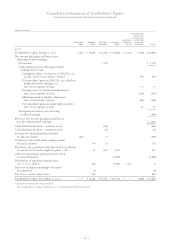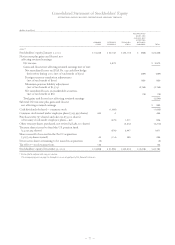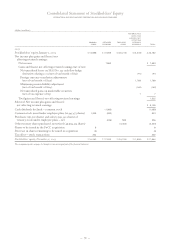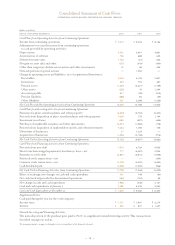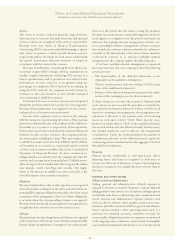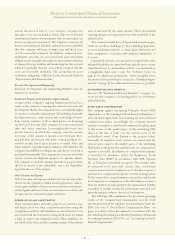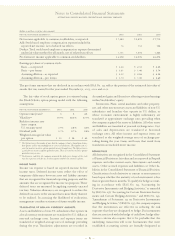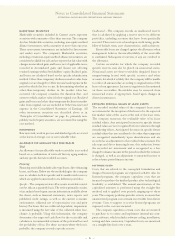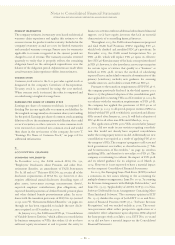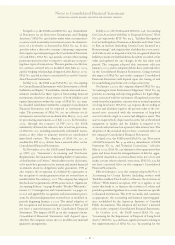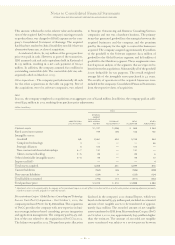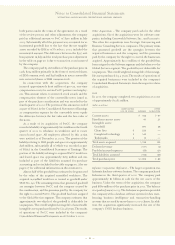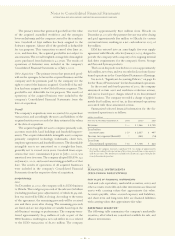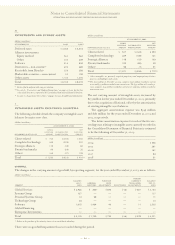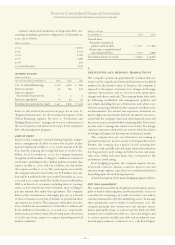IBM 2003 Annual Report Download - page 88
Download and view the complete annual report
Please find page 88 of the 2003 IBM annual report below. You can navigate through the pages in the report by either clicking on the pages listed below, or by using the keyword search tool below to find specific information within the annual report.
PRODUCT WARRANTIES
The company estimates its warranty costs based on historical
warranty claim experience and applies this estimate to the
revenue stream for products under warranty. Included in the
company’s warranty accrual are costs for limited warranties
and extended warranty coverage. Future costs for warranties
applicable to revenue recognized in the current period are
charged to cost of revenue. The warranty accrual is reviewed
quarterly to verify that it properly reflects the remaining
obligation based on the anticipated expenditures over the
balance of the obligation period. Adjustments are made when
actual warranty claim experience differs from estimates.
COMMON STOCK
Common stock refers to the $.20 par value capital stock as
designated in the company’s Certificate of Incorporation.
Treasury stock is accounted for using the cost method.
When treasury stock is reissued, the value is computed and
recorded using a weighted-average basis.
EARNINGS PER SHARE OF COMMON STOCK
Earnings per share of common stock-basic is computed by
dividing Net income applicable to common stockholders by
the weighted-average number of common shares outstanding
for the period. Earnings per share of common stock-assuming
dilution reflects the maximum potential dilution that could
occur if securities or other contracts to issue common stock
were exercised or converted into common stock and would
then share in the net income of the company. See note T,
“Earnings Per Share of Common Stock,” on page 108 for
additional information.
B
accounting changes
STANDARDS IMPLEMENTED
In December 2003, the FASB revised SFAS No. 132,
“Employers’ Disclosures about Pensions and other Post-
retirement Benefits, an amendment of FASB Statements
No. 87, 88 and 106.” This new SFAS No. 132 retains all of the
disclosure requirements of SFAS No. 132; however, it also
requires additional annual disclosures describing types of
plan assets, investment strategy, measurement date(s),
expected employer contributions, plan obligations, and
expected benefit payments of defined benefit pension plans
and other defined benefit postretirement plans. In accor-
dance with the transition provisions of SFAS No. 132 (revised
2003), note W, “Retirement-Related Benefits,” on pages 110
through 117 has been expanded to include the new disclo-
sures required as of December 31, 2003.
In January 2003, the FASB issued FIN 46, “Consolidation
of Variable Interest Entities,” which addresses consolidation
by business enterprises of VIEs that either: (1) do not have
sufficient equity investment at risk to permit the entity to
finance its activities without additional subordinated financial
support, or (2) have equity investors that lack an essential
characteristic of a controlling financial interest.
Throughout 2003, the FASB released numerous proposed
and final FASB Staff Positions (FSPs) regarding FIN 46,
which both clarified and modified FIN 46’s provisions. In
December 2003, the FASB issued Interpretation No. 46
(FIN 46-R), which will replace FIN 46 upon its effective
date. FIN 46-R retains many of the basic concepts introduced
in FIN 46; however, it also introduces a new scope exception
for certain types of entities that qualify as a “business” as
defined in FIN 46-R, revises the method of calculating
expected losses and residual returns for determination of the
primary beneficiary, includes new guidance for assessing
variable interests, and codifies certain FSPs on FIN 46.
Pursuant to the transition requirements of FSP FIN 46-6,
the company previously disclosed in the third quarter 2003
Form 10-Qthe planned adoption of the consolidation guid-
ance applicable to existing VIEs as of December 31, 2003. In
accordance with the transition requirements of FIN 46-R,
the company has applied the provisions of FIN 46 as of
December 31, 2003, to all special-purpose entities (SPEs) as
defined within FIN 46-R to which it is associated and all non-
SPEs created after January 31, 2003. It will defer adoption of
FIN 46-R for all other non-SPEs until March 31, 2004.
The application of FIN 46 to VIEs created after January
31, 2003, did not result in any entities requiring consolida-
tion that would not already have required consolidation
under the voting equity interest model. Additionally, no new
consolidation was required as a result of applying FIN 46 to
the company’s SPEs. The company’s program to sell state and
local government receivables, as described in note J, “Sale
and Securitization of Receivables,” on page 95, involves
qualifying SPEs, and therefore is not subject to FIN 46. The
company is continuing to evaluate the impact of FIN 46-R
and its related guidance for its adoption as of March 31,
2004. However, it is not expected to have a material impact
on the company’s Consolidated Financial Statements.
In 2003, the Emerging Issues Task Force (EITF) reached
a consensus on two issues relating to the accounting for
multiple-element arrangements: Issue No. 00-21, “Accounting
for Revenue Arrangements with Multiple Deliverables,” and
Issue No. 03-05, “Applicability of AICPA SOP 97-2 to Non-
Software Deliverables in an Arrangement Containing More
Than Incidental Software.” The consensus opinion in EITF
No. 03-05 clarifies the scope of both EITF 00-21 and State-
ment of Financial Position (SOP) 97-2, “Software Revenue
Recognition,” and was reached on July 31, 2003. The transi-
tion provisions allow either prospective application or a
cumulative effect adjustment upon adoption. IBM adopted
the Issue prospectively as of July 1, 2003. EITF Nos. 00-21 and
03-05 did not have a material impact on the Consolidated
Financial Statements.
Notes to Consolidated Financial Statements
INTERNATIONAL BUSINESS MACHINES CORPORATION AND SUBSIDIARY COMPANIES
86


